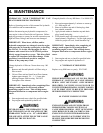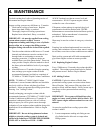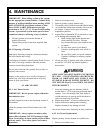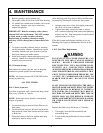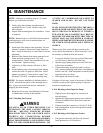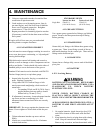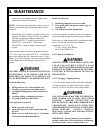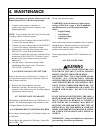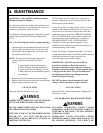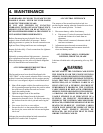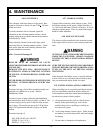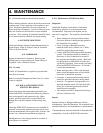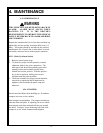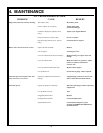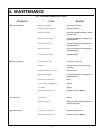
- 43 -
4. MAINTENANCE
WARNING
specifications. Only qualified technicians should
attempt fuel injector diagnose.
Fuel injection nozzles are usually removed and tested
or replaced when there is a noticeable loss of power or
excessive smoking after break-in period.
For detailed testing and diagnostic information on fuel
system refer to John Deere Technical Manual (P/N
55321).
4.19.1 Test Fuel Injection Nozzles (engine running)
1. Operate engine at intermediate speed and no load.
2. Slowly loosen the fuel pressure line at one of the
nozzles until fuel escapes at the connection (fuel
not opening nozzle valve).
NOTE: The injection nozzle before and/or after
nozzle being checked could be the faulty
nozzle.
If engine speed changes, the injection
nozzle is probably working satisfactory.
If engine speed does not change, a nozzle
is faulty and must be checked and repaired
(or replaced).
3. Repeat test for each remaining nozzle assembly.
4. Remove faulty injection nozzles and see authorized
engine dealer or replace with new.
4.20 FUEL TANK
Drain and flush the fuel tank every year.
HANDLE FUEL CAREFULLY. DO NOT FILL THE
FUEL TANK WHEN ENGINE IS RUNNING.
DO NOT SMOKE WHILE FILLING FUEL TANK
OR SERVICING FUEL SYSTEM.
THE FUEL TANK IS VENTED THROUGH THE
FILLER CAP. IF A NEW FILLER CAP IS
REQUIRED, ALWAYS REPLACE IT WITH AN
ORIGINAL VENTED CAP.
Fill fuel tank at the end of each days operation to
prevent condensation in tank as moist air cools and
freezing during cold weather.
Avoid storing fuel over long periods of time. If fuel is
stored for more than a month prior to use or there is a
slow turnover in fuel tank or supply tank, add a fuel
conditioner such as John Deere PREMIUM DIESEL
FUEL CONDITIONER or equivalent to stabilize the
fuel and prevent water condensation. John Deere
PREMIUM DIESEL FUEL CONDITIONER is
available in winter and summer formulas. Fuel
conditioner also reduces fuel gelling and controls wax
separation during cold weather.
Proper fuel storage is critically important. Use clean
storage and transfer tanks. Periodically drain water and
sediment from bottom of tank. Store fuel in a
convenient place away from buildings.
IMPORTANT: DO NOT store diesel fuel in
galvanized containers. Diesel fuel stored in
galvanized containers reacts with zinc coating on
container to form zinc flakes. If fuel contains water,
a zinc gel will also form. The gel and flakes will
quickly plug fuel filters and damage injection
nozzles and injection pump.
DO NOT use brass-coated containers for fuel
storage. Brass is an alloy of copper and zinc.
4.21 FUEL LINES
Inspect fuel line condition and clamps. Replace fuel
lines every 2 years.
4.22 HYDRAULIC HOSES/CONNECTIONS
ESCAPING HYDRAULIC FLUID UNDER
PRESSURE CAN HAVE SUFFICIENT FORCE TO
PENETRATE THE SKIN, CAUSING SERIOUS
PERSONAL INJURY.
HYDRAULIC FLUID ESCAPING UNDER
PRESSURE FROM A VERY SMALL HOLE CAN
BE ALMOST INVISIBLE. USE A PIECE OF
WARNING



